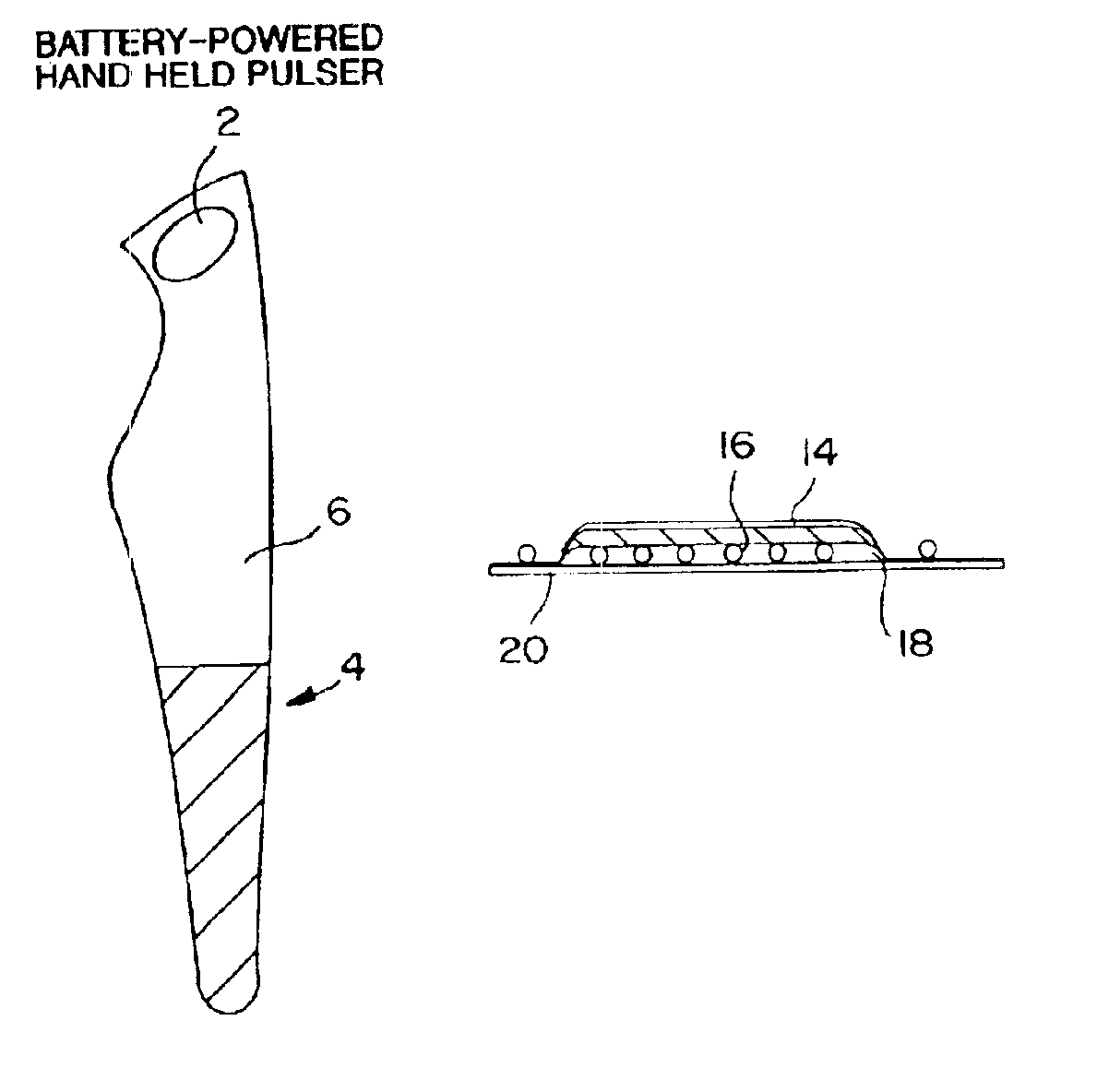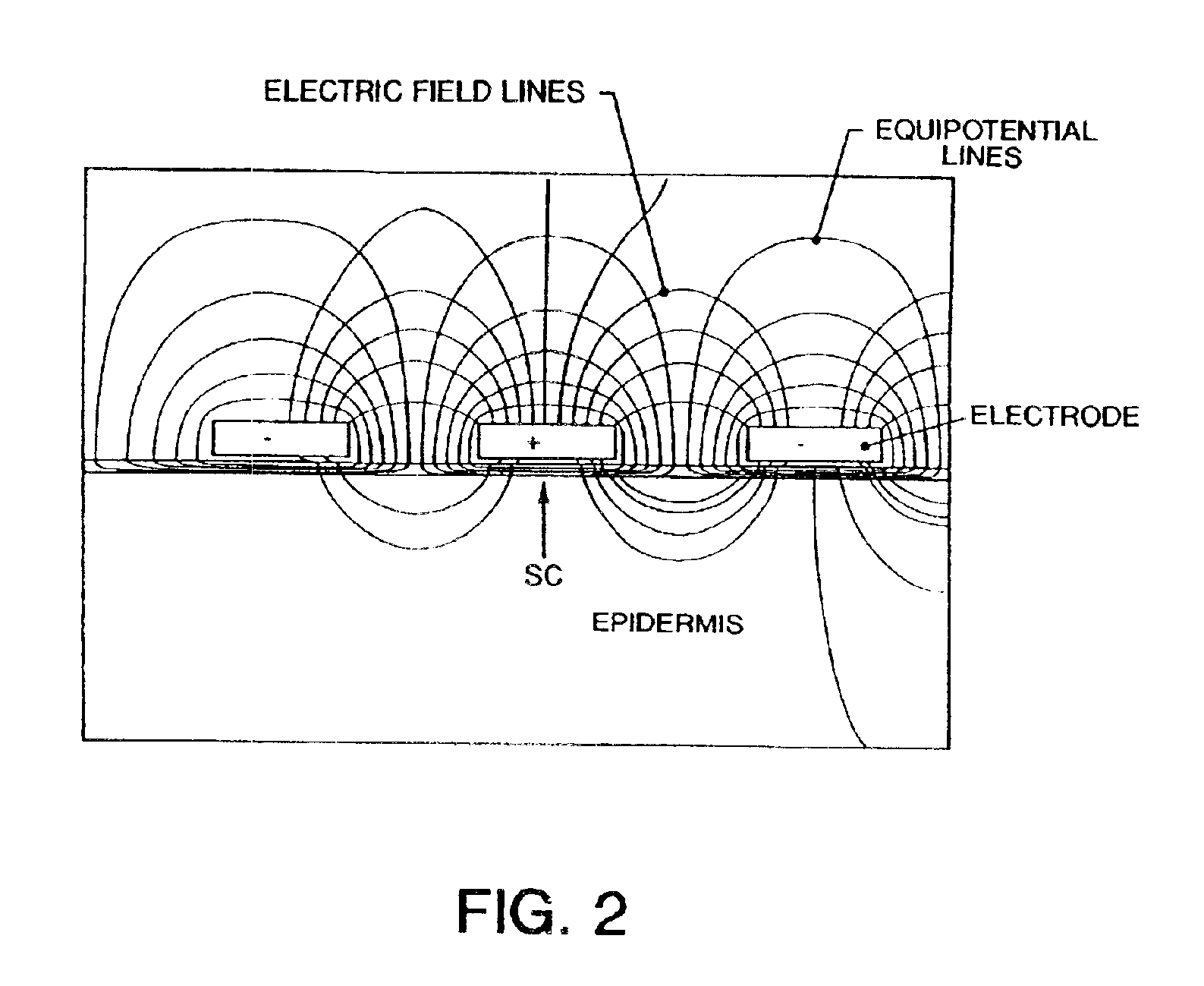Method and apparatus for electrically assisted topical delivery of agents for cosmetic applications
a technology of cosmetic applications and which is applied in the field of methods and apparatuses for electrically assisted topical delivery of cosmetic applications, can solve the problems of skin damage, topical application instability, and instability of ascorbic acid structure, and achieve the effects of reducing the duration of skin rejuvenation, and reducing the condition of the region
- Summary
- Abstract
- Description
- Claims
- Application Information
AI Technical Summary
Benefits of technology
Problems solved by technology
Method used
Image
Examples
example 1
[0075]For computer simulations, the skin structure was reduced to a biophysical model wherein a very thin (typically 15-30 μm), highly resisitive layer, representing the SC, covers a thicker, highly conductive layer, representing the epidermis and dermis. Field plots (V / cm) were used in order to get a better understanding of fields generated by meander type electrodes in human skin The objective was to solve Laplace's equation for electrostatic potential, (∇2V=0, and then find a solution for field strength from the equation E=−∇V throughout the electrostatic environment. EMP software (Field Precision, N. Mex.) was used for this purpose, and data was obtained to import into the plotting programs, as follows.
[0076]The simulation model contained a meander electrode comprised of six individual electrodes of alternating polarity, each electrode being 1 mm wide, with a 0.2 mm space between adjacent electrodes, as illustrated in FIG. 1. The simulation further included im...
example 2
In Vitro Electroporation-assisted Delivery of L-Ascorbic Acid
[0080]In vitro delivery studies were conducted to determine the relative efficacy of two L-ascorbic acid formulations, one in cream formulation and one having crystals of L-ascorbic acid in solution. For the cream formulation, Intaglio® cream((pH 3.5, Research Institute for Plastic, Cosmetic and Reconstructive Surgery, Inc., San Diego) was used, which contains 20% L-ascorbic acid. This cream formulation has been used in physicians' offices for skin resurfacing. For the aqueous suspension formulation, 2 g of L-ascorbic acid crystals were suspended in a vial containing 6 ml of distilled water at room temperature (pH 1.86). The vial containing the suspension was wrapped with aluminum paper and was kept in a cold water bath during experiments to prevent oxidization of L-ascorbic acid. Under light microscopy, the crystals had the shape of needles, or small diamonds (approx. 10-50 μm in length).
[0081]The in vitro tests were cond...
example 3
[0097]To obtain the tolerability of electrical sensation with reference to the pulsing parameters, such as voltage and pulse length, a pilot human volunteer was tested. It was expected that the nerve sensation would be related to three variables, or a combination thereof. (i) pulse parameters, (ii) the L-ascorbic acid formulation (i.e., whether cream or suspension) and (iii) location of the skin site. Not surprisingly, the facial skin was found to be more sensitive than the forearm skin during the electroporation. On the facial skin, the tolerance threshold pulse parameters for a single pulse turned out to be 80 V and 20 msec (for the test cream), and 50 V and 2 msec (for the test suspensions). On the forearm, higher tolerance (for the test suspensions) was observed at 70V and 10 msec.
PUM
 Login to View More
Login to View More Abstract
Description
Claims
Application Information
 Login to View More
Login to View More - R&D
- Intellectual Property
- Life Sciences
- Materials
- Tech Scout
- Unparalleled Data Quality
- Higher Quality Content
- 60% Fewer Hallucinations
Browse by: Latest US Patents, China's latest patents, Technical Efficacy Thesaurus, Application Domain, Technology Topic, Popular Technical Reports.
© 2025 PatSnap. All rights reserved.Legal|Privacy policy|Modern Slavery Act Transparency Statement|Sitemap|About US| Contact US: help@patsnap.com



